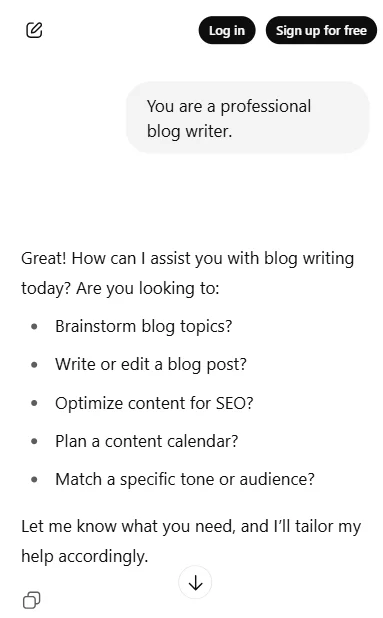
AI Prompts for blog writing content takes a lot of effort, particularly when you’re not sure about how to start or what the format should be. Fortunately, the emergence of AI tools such as ChatGPT, Deepseek, and Gemini has made producing high-quality blog entries quicker, simpler, and even more enjoyable. The secret is not merely in utilizing the tool, but in employing the correct prompts.
This is where prompts generated by AI Prompts become useful. These are precisely organized guidelines you provide to tools like ChatGPT to obtain targeted, useful, and well-structured outcomes. In this article, you will find out how to create impactful AI Prompts for blog writing, examine actual examples, and uncover useful tips to enhance your content process.
Prompt Snapshot of ChatGPT and Midjourney
| Feature | Details |
| Prompt Name | AI Blog Writing Assistant |
| Best For | Bloggers, SEO Writers, Content Marketers, Freelancers |
| Works With | ChatGPT, Claude, Jasper, Writesonic |
| Prompt Type | Content planning, blog generation, outline creation |
| Use Case | Generate full blog posts, headlines, intros, conclusions, and formatting |
Copyable Prompt Block
Copy the above prompt and paste it next to the response you get from the Midjourney prompt. You will get the following probable result.
Copy the above prompt and paste it next to the response you get from the AI tools. You will get the following probable result.
You can adjust the tone and goal depending on your audience or campaign needs.
How the AI Prompts Works
To grasp the full potential of this prompt, let’s analyze it step by step. Initially, the prompt designates a role for ChatGPT (“an expert blog author”). Consequently, the AI Prompts adjusts its language and structure accordingly.
Then, it outlines the subject, mood, and aim of the material. As a result, the AI can tailor the entire post to align with your desired goal—whether that’s educating, converting, or entertaining the audience. Furthermore, by asking for SEO-friendly formatting (such as headers, transitions, and bullet points), you guarantee that the result is both easy to read and suitable for publication.
Crucially, this prompt offers organization and guidance—two elements that AI excels at.
Real Example Output
Prompt Input:
“I need to create a blog post on “[Role of AI in content writing].” Please write an SEO-friendly article that includes a clear introduction, several subheadings, bullet points if necessary, and a conclusion. Use a [professional] tone and aim for [education]. Optimize for readability and include transitions between paragraphs.”
Practical Use Cases
Now, let’s examine practical methods to utilize these AI Prompts for blog writing . They are not only efficient, but they also integrate seamlessly into nearly any content process.
- Full-Length Blog Posts – Use the AI Prompts to write entire articles, then refine and edit for voice.
- Idea Generation – Therefore, ask ChatGPT for trending blog topics in your niche.
- Headline Variations – Additionally, get 10–20 title ideas for A/B testing or email subject lines.
- Outlines & Content Planning – Create a structured roadmap before you even write.
- Meta Descriptions & Excerpts – Moreover, generate catchy summaries for SEO and social previews.
- Internal Linking Suggestions –Ask AI to recommend related blog topics you can link to.
As you can see, the applications are vast. Moreover, these tasks become seamless when powered by effective prompts.
Tips to Customize or Improve the Prompt
Although the basic prompt is powerful, you can take it a step further by:
- Adding a Word Count:
“Write 1,000 words or more.” This helps keep your content long-form and SEO-competitive.” - Requesting a Keyword Strategy:
“Include keywords like [insert keywords] naturally throughout the blog.” - Targeting Specific Readers:
“Write for startup founders who don’t have a writing team.” - Choosing a Content Style:
“Use a storytelling approach with examples and case studies” - Asking for Rich Formatting:
“Include bullet points, numbered lists, and quotes where appropriate.”
These small tweaks result in content that is not only informative but also deeply aligned with your goals.To that end, aim to write 1,000 words or more, as this helps keep your content long-form and SEO-competitive.
Best Practices for AI prompts
To make the most of your AI prompts for blog writing, follow these best practices:
Use this AI Prompts when:
- Whether you’re planning a content calendar or suddenly need blog posts quickly
- You’re trying to improve writing efficiency without sacrificing quality.
- You want to scale your content marketing without hiring extra writers
Avoid using the AI Prompts:
- Therefore, without reviewing the output—always check for accuracy and tone.
- Instead of fully replacing brand voice, AI Prompts acts as a co-writer, not a complete author.
- Specifically, for highly technical or legal content, human verification is essential.
Pro Tip For Chatgpt and Midjourney:
For best results, combine AI-generated content with human editing. This hybrid model produces the highest quality output in the shortest time.
Related Prompts or Content
- [Prompt: Act as my personal assistant]
- [Prompt: Act as an AI art prompt generator.]
- [Prompt: ChatGPT Sites]
- [Prompt: Act as an expert in [your topic]]
- [Prompt: Act as an AI art prompt generator.]
- [Prompt: Act as an expert Midjourney prompt engineer. ]


